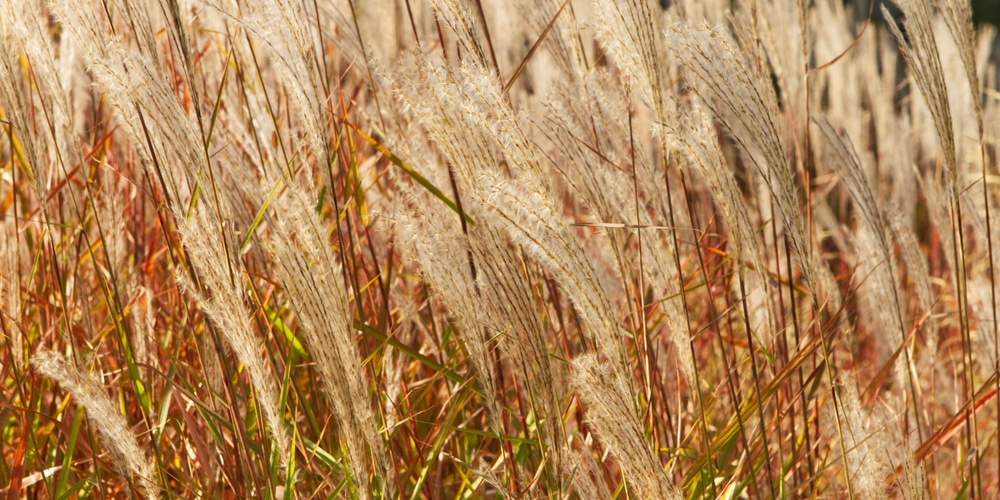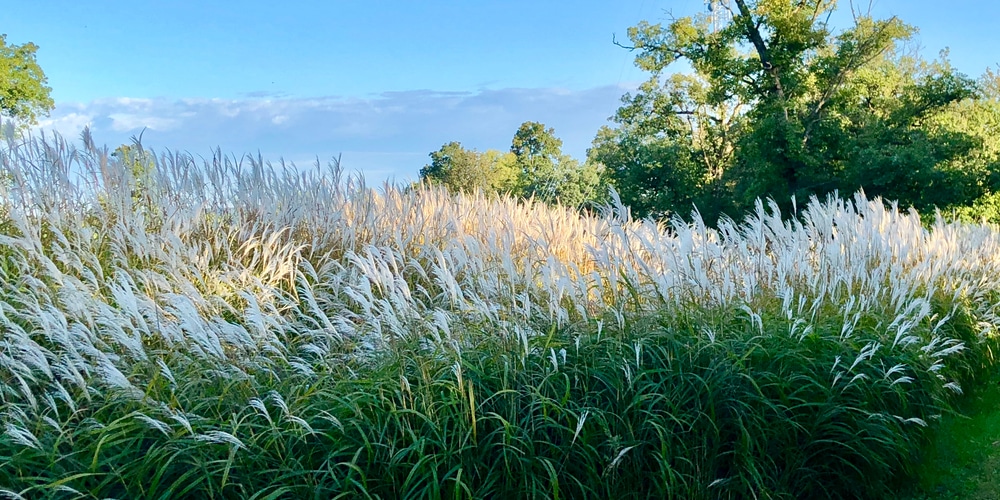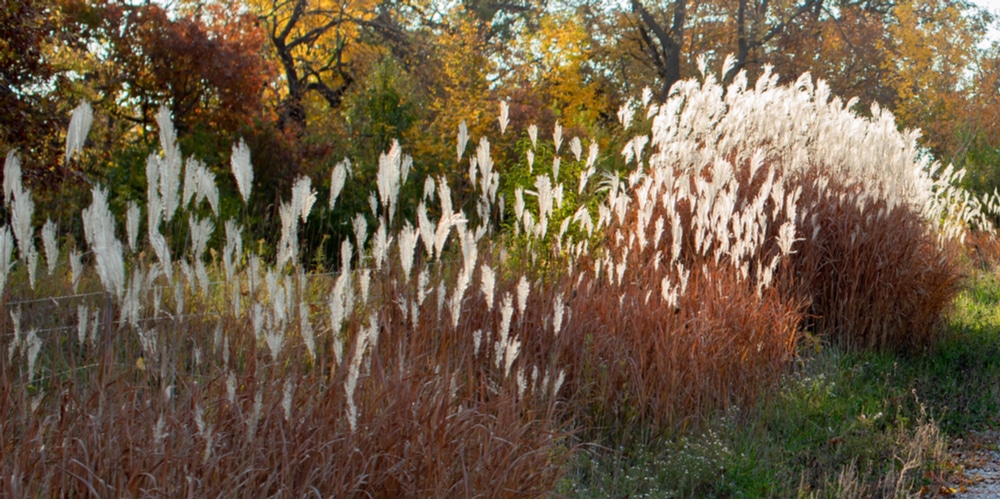Flame grass is one of the most beautiful ornamental grasses you’ll ever see. The blade-like leaves are a brilliant golden yellow color that is tipped with red. This plant produces an impressive upright stalk covered in tiny flowers that are a delicate pinkish-white.
Most people use this plant in their gardens and landscaping, but it is also used for decoration inside the home as well.
If you have ever considered adding flame grass to your garden or landscape, or if you are curious about how to care for a flame grass that has been added to your home decor, then read on!

| Botanical Name | Miscanthus ‘Purpurascens’ |
| Common Name | Flame grass |
| Plant Type | Perennial |
| Flower Color | Light pink |
| Size When Mature | 47-59 inches |
| Bloom Time | Late summer to mid-fall |
| Sun Requirements | Full Sun tolerates Partial Shade |
| USDA Hardiness Zones | 4-8 |
| Soil PH Range | 5.8-7.0 |
| Soil Type | Acidic to neutral, sandy, clay, moist, well-drained |
| Water Needs | Low to medium |
| Native Area | Asia |
What You Need to Know About Flame Grass
Flame grass is a beautiful and unique plant that is prized by gardeners everywhere. With its vibrant red blades of grass and sunny yellow flowers, this plant brings an explosion of color to any outdoor space.
Its flowers bloom in the summer and last well into the fall, making these seasons even more enjoyable in your garden. And while it is certainly eye-catching, there is much more to flame grass than just its stunning appearance.
It is extremely easy to grow and care for – even novice gardeners can get this plant thriving in no time. And with its deep root system, flame grass also makes for a great natural erosion control tool, as it helps to anchor the ground and prevent soil from being washed away.
In short, if you are looking for a beautiful addition to your outdoor space that requires minimal effort on your part, then flame grass should definitely be at the top of your list!
How to Care for Flame Grass
If you are ready to add flame grass to your garden or landscape, then here’s what you need to know about growing and caring for a thriving flame grass.
Light
When it comes to caring for flame grass, light is one of the most critical factors. This species does best in full sun, so it should ideally be placed in a location where it will get plenty of direct sunlight throughout the day. Plant in a location that gets full sun to part shade. The more sun, the more intense the foliage color will be.
However, if you don’t have a spot that receives lots of natural light, you may be able to get away with placing your flame grass plant near a sunny window instead. Just be sure to rotate the plant periodically to ensure that all sides receive an equal amount of light.
Water and Soil Needs
Flame grass isn’t particular about soil type as long as it has good drainage. Once established, this plant is quite drought resistant. Water regularly during the first growing season to establish an extensive root system. After that, only occasional watering is needed to keep the foliage looking its best.
If you live in an area with hot summers and little rainfall, supplemental water may be necessary. This is especially true if your flame grass is growing in a pot, as potted plants tend to dry out more quickly than those that are planted directly in the ground.
This plant thrives and does well in soil with pH levels of 5.8 to 7.0, with moist and well-drained soil.
Temperature Requirements
This beautiful grass thrives in warm climates and is best suited for USDA hardiness zones 4-8. Because of its heat and drought tolerance, it can also be grown in zones 9-10 as an annual. Its ideal growing temperature is between 60 to 75 degrees Fahrenheit.
To care for your flame grass during hot weather or periods of drought, simply water regularly and apply a thick layer of mulch around the base of the plant. This will help to keep your flame grass hydrated, protect its roots from heat damage, and prevent weeds from growing.
Fertilizer
The best fertilizer for flame grass is a slow-release, medium-rate fertilizer. This provides the plant with vital nutrients without overwhelming its sensitive roots. Because it relatively grows at a medium to fast pace and has a deep root system, flame grass requires plenty of nutrients to grow strong and stay healthy.
To apply fertilizer, use a spreader and carefully follow the fertilizer packaging instructions. Start by spreading a layer of fertilizer down at least 6 inches away from the base of your plant. Then, water thoroughly to ensure that all of the fertilizer is absorbed. You will only need to fertilize once a year, and this should be done in the late spring or early summer.
Common Diseases
When it comes to flame grass, there are a few common diseases that gardeners should be aware of. The first is rust, which is caused by a fungoid parasite that attacks the roots and crowns of the plant. Symptoms include yellow-brown spots on leaves and distorted flowers.
Another common disease is powdery mildew, which can cause withering and death of young stems. Finally, looking out for puffball fungus is important; this infection manifests as white or pink dusty spores on leaves, branches, or flowers. Taking these conditions into account will help you care for your flame grass plants properly so that they thrive and stay healthy.
Because this plant has long, narrow leaves, it is also susceptible to leaf spots. This fungal disease manifests as small, dark spots on the leaves. If left untreated, leaf spots can cause the leaves to be yellow and eventually drop off.
Flame Grass Propagation
This striking plant is native to China and Japan. In its native habitat, Miscanthus ‘Purpurascens’ grows in damp, shadowy areas. This plant is easily propagated from seed. The seeds should be sown in a well-drained soil mix and kept moist until they germinate.
Once the seedlings have emerged, they can be transplanted into individual pots or planted out in the garden. Water the soil around the young plants several times each week and give them a layer of mulch to help retain moisture.
Flame Grass Care: Final Thoughts
With its long leaves and eye-catching color, flame grass is a beautiful addition to any garden.
To ensure that your plants thrive and stay happy, be sure to provide them with plenty of moisture and fertilize them once a year in the late spring or early summer. Also watch out for common diseases like leaf spots and rust.
While they’re relatively easy to care for, a little bit of TLC goes a long way when it comes to keeping these plants looking their best.
Related Article: 6 Ways to Stop Grass Growing Through Rocks.

